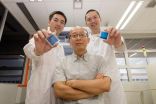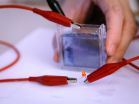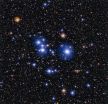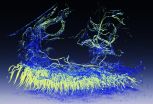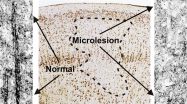(Press-News.org) Nanyang Technological University (NTU Singapore) scientists have developed a smart window which can darken or brighten without the need for an external power source.
This unique self-tinting window requires zero electricity to operate and is also a rechargeable battery. The window's stored energy can be used for other purposes, such as to light up low-powered electronics like a light emitting diode (LED).
Currently, the window solutions in the market are either using permanent tinting which cannot brighten at night or are windows that can change its light transmission properties only with an external power source.
The NTU smart window however can be turned into a cool blue tint in bright daylight, cutting light penetration by about half, and then reverts back to clear glass at night or as required.
This breakthrough research led by NTU Professor Sun Xiaowei, was published recently in Nature Communications, a prestigious peer-reviewed scientific journal.
How it works
The trick to making the self-powered smart window is a new technology developed by Prof Sun's team from NTU's School of Electrical and Electronic Engineering.
"Our new smart electrochromic window is bi-functional; it is also a transparent battery," Prof Sun explained. "It charges up and turns blue when there is oxygen present in the electrolyte - in other words, it breathes."
The NTU smart window contains liquid electrolyte placed in between two glass sheets coated with indium tin oxide (ITO), commonly used as transparent conductive coatings for television displays. One sheet is coated with an additional layer of a pigment known as Prussian Blue and the other one is attached to a thin strip of aluminium foil. The Prussian Blue gives the glass a blue tint when it is fully charged.
The two glass sheets are connected by typical electrical cables. When the electrical circuit between them is broken, a chemical reaction starts between Prussian Blue and the dissolved oxygen in the electrolyte, turning the glass blue. To turn off the blue tint, the electrical circuit is closed to discharge the battery, turning the Prussian Blue into a colourless Prussian White.
Such an innovative technology can adjust the amount of sunlight coming into buildings in the day, which promises significant savings on cooling and lighting costs.
"Our technology is very attractive as a zero-sum consumption smart window. Buildings owners and even common households can reap energy savings right from the outset and over the long term. Developers who are looking at constructing environmentally-friendly green buildings will find our technology attractive for their building plans," said Prof Sun.
Prof Sun is an electrical engineering expert whose other innovations include various solar technologies, glass-free 3D technologies, next-generation lightings and displays.
The NTU team is now enhancing their invention and is looking forward to collaborating with industry partners to commercialise their technology.
INFORMATION:
Media contact:
Lester Kok
Senior Assistant Manager
Corporate Communications Office
Nanyang Technological University, Singapore
Email: lesterkok@ntu.edu.sg
About Nanyang Technological University
A research-intensive public university, Nanyang Technological University (NTU) has 33,500 undergraduate and postgraduate students in the colleges of Engineering, Business, Science, Humanities, Arts, & Social Sciences, and its Interdisciplinary Graduate School. It has a new medical school, the Lee Kong Chian School of Medicine, set up jointly with Imperial College London.
NTU is also home to world-class autonomous institutes - the National Institute of Education, S Rajaratnam School of International Studies, Earth Observatory of Singapore, and Singapore Centre on Environmental Life Sciences Engineering - and various leading research centres such as the Nanyang Environment & Water Research Institute (NEWRI), Energy Research Institute @ NTU (ERI@N) and the Institute on Asian Consumer Insight (ACI).
A fast-growing university with an international outlook, NTU is putting its global stamp on Five Peaks of Excellence: Sustainable Earth, Future Healthcare, New Media, New Silk Road, and Innovation Asia.
Besides the main Yunnan Garden campus, NTU also has a satellite campus in Singapore's science and tech hub, one-north, and a third campus in Novena, Singapore's medical district.
For more information, visit http://www.ntu.edu.sg
A team of biologists has identified a set of nerve cells in desert locusts that bring about 'gang-like' gregarious behaviour when they are forced into a crowd.
Dr Swidbert Ott from the University of Leicester's Department of Biology, working with Dr Steve Rogers at the University of Sydney, Australia, has published a study that reveals how newly identified nerve cells in locusts produce the neurochemical serotonin to initiate changes in their behaviour and lifestyle.
The findings demonstrate the importance of individual history for understanding how brain chemicals ...
Messier 47 is located approximately 1600 light-years from Earth, in the constellation of Puppis (the poop deck of the mythological ship Argo). It was first noticed some time before 1654 by Italian astronomer Giovanni Battista Hodierna and was later independently discovered by Charles Messier himself, who apparently had no knowledge of Hodierna's earlier observation.
Although it is bright and easy to see, Messier 47 is one of the least densely populated open clusters. Only around 50 stars are visible in a region about 12 light-years across, compared to other similar objects ...
Treating bacterial infections with antibiotics is becoming increasingly difficult as bacteria develop resistance not only to the antibiotics being used against them, but also to ones they have never encountered before. By analyzing genetic and phenotypic changes in antibiotic-resistant strains of E. coli, researchers at the RIKEN Quantitative Biology Center (QBiC) in Japan have revealed a common set of features that appear to be responsible for the development of resistance to several types of antibiotics.
The study published in Nature Communications shows that resistance ...
Fireflies used rapid light flashes to communicate. This "bioluminescence" is an intriguing phenomenon that has many potential applications, from drug testing and monitoring water contamination, and even lighting up streets using glow-in-dark trees and plants. Fireflies emit light when a compound called luciferin breaks down. We know that this reaction needs oxygen, but what we don't know is how fireflies actually supply oxygen to their light-emitting cells. Using state-of-the-art imaging techniques, scientists from Switzerland and Taiwan have determined how fireflies control ...
This news release is available in French. This news release is available in French.
People with a severe mental disorder who commit a crime and who are incarcerated have different characteristics compared to people who are hospitalized after committing an offence. These are the findings of a study by researchers at the Institut universitaire en santé mentale de Montréal (IUSMM) and the Institut Philippe-Pinel de Montréal (IPPM), affiliated with the University of Montreal.
"We found a clear difference between people with a mental illness who are ...
Cancer Research UK scientists have shown that loss of a gene called PTEN triggers some cases of an aggressive form of ovarian cancer, called high-grade serous ovarian cancer, according to a study published in Genome Biology today (Wednesday)*.
In a revolutionary approach the researchers from the Cancer Research UK Cambridge Institute made the discovery by combining images from cancer samples with genetic data. They proved conclusively that loss of PTEN was commonly found only in the cancerous cells and not the 'normal' cells that help make up the tumour mass.
PTEN ...
Using an innovative technique combining genetic analysis and mathematical modeling with some basic sleuthing, researchers have identified previously undescribed microlesions in brain tissue from epileptic patients. The millimeter-sized abnormalities may explain why areas of the brain that appear normal can produce severe seizures in many children and adults with epilepsy.
The findings, by researchers at the University of Illinois at Chicago College of Medicine, Wayne State University and Montana State University, are reported in the journal Brain.
Epilepsy affects about ...
The deep sea is becoming a collecting ground for plastic waste, according to research led by scientists from Plymouth University and Natural History Museum.
The new study, published today in Royal Society Open Science, reveals around four billion microscopic plastic fibres could be littering each square kilometre of deep sea sediment around the world.
Marine plastic debris is a global problem, affecting wildlife, tourism and shipping. Yet monitoring over the past decades has not seen its concentration increase at the sea surface or along shorelines, despite experts ...
New research suggests our jawed ancestors weren't responsible for the demise of their jawless cousins as had been assumed. Instead Dr Robert Sansom from The University of Manchester believes rising sea levels are more likely to blame. His research has been published in the journal Proceedings of the Royal Society B.
He says: "When our jawed vertebrate ancestors overtook their jawless relatives 400 million years ago, it seems that it might not have been through direct competition but instead the inability of our jawless cousins to adapt to changing environmental conditions."
In ...
In another demonstration that brain-computer interface technology has the potential to improve the function and quality of life of those unable to use their own arms, a woman with quadriplegia shaped the almost human hand of a robot arm with just her thoughts to pick up big and small boxes, a ball, an oddly shaped rock, and fat and skinny tubes.
The findings by researchers at the University of Pittsburgh School of Medicine, published online today in the Journal of Neural Engineering, describe, for the first time, 10-degree brain control of a prosthetic device in which ...
